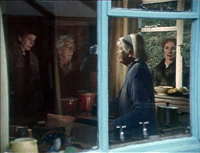Five years before Abbas Kiarostami would blur the delineation between documentary and fiction in Close-Up by casting underemployed laborer and accused Mohsen Makhmalbaf impersonator, Sabzian to participate in a re-enactment of his fateful encounter with Mrs. Mahrokh Ahankhah and his subsequent deception of the Ahankhah family by ingratiating himself into their company, Françoise Romand would channel the spirit of dramatist Luigi Pirandello’s recurring preoccupation with the interpenetration between art and reality in the thoughtful and poignant, yet fascinating, idiosyncratically offbeat, and whimsical first feature, Mix-Up to explore similar Pirandellian themes of identity, destiny, and absurdity. The maternity ward of a small, Nottingham hospital in 1936 serves as the literal and metaphoric stage for the story, as Blanche Rylatt, one of the two mothers involved in the “baby mix-up affair”, recounts her admission into the delivery room to fill out the necessary documentation in preparation for the birth of her first child, only to be asked if she would voluntarily vacate the room (leaving all of her paperwork on the table in the hastily arranged move) in order to accommodate another patient, Margaret Wheeler, who was already in a more advanced stage of delivery. Ingeniously shot from the waiting room of a hospital nursery, the now elderly women take turns in front of the viewing window to recount their birth stories, punctuated by the appearance of their respective daughters beside them …or so it seems, as a disembodied hand reaches over to tap the arm of Blanche’s biological daughter, Valery in a pre-arranged cue to stand beside her foster mother, Margaret, while Margaret’s biological daughter, Peggy, in turn, once again returns to the foreground, this time, standing beside her foster mother, Blanche.
Already discomfited by the hospital staff’s frequent misdirection of flowers and correspondences between the two mothers, Margaret becomes immediately convinced that the daughter given to her was not the baby shown to her during the delivery, a misgiving dismissed by the hospital staff as a common uncertainty expressed by many mothers overwhelmed by the birth of a new child. Without conclusive proof, Margaret sought to insinuate herself into the Rylatt family’s life by any means necessary in order to maintain contact with the family (and above all, Peggy), asking Blanche’s husband, Fred to become Valery’s godfather, paying occasional visits to the family (as well as surreptitiously sending family and friends to view baby Peggy in the hopes of gleaning conclusive information from a third-person opinion), and even sending several photographs of Valery over the years as a courtesy to the family. In contrast, Blanche, placated by their family doctor’s reassurances that Peggy was the child whom he had helped deliver, and frequent comments from family and friends on Peggy’s resemblance to other members of their extended family (as well as Fred’s own conscious attempts to insulate her from Margaret’s skeptical instigations), never truly doubted that Peggy was her biological child and showered her with the a kind of over-attentive, doting affection parents often have for their first-born child.
Composed of first-hand accounts of the daughters’ childhood (and in particular, Valery’s bittersweet expression of her youthful insecurities and incongruous sense of place within the Wheeler household), dramatized re-enactments, impressions and recollections by family and friends (cleverly shot as they all ride the same double-decker bus that underscores the themes of chance and convergences in seemingly random situations and interconnected degrees of separation), and interstitial tableaux that visually illustrate the complex dynamics of the families’ relationships, the film straddles – if not, upends – the bounds of documentary and fiction in its idiosyncratic fusion of first-person testimonial narrative and Romand’s creative infusion in her reconstruction (or rather, reconstitution) of the life-altering – and enriching – aftermath of Peggy and Valery’s accidental switching. Romand’s repeated incorporation of sharp geometries and mirrored images serve, not only to symbolize the irony of the perturbated, parallel lives of the Rylatt and Wheeler households (a consuming and seemingly irreconcilable predicament that would embolden Margaret to initiate such uncharacteristic acts as corresponding with leading scientific and legal experts of the day on finding conclusive proof of the children’s parentage, and even seeking advice and emotional support from famed playwright and Nobel Prize-winning author, George Bernard Shaw), but also to illustrate the irreparably altered trajectories of their destinies. Inevitably, it is through these enlightened observations, comic asides, and eccentric tangents that Mix-Up incisively illustrates with liberating humor and pathos the refractions of fate and arbitrary chance that reinforce the poetry and absurdity of everyday life.
